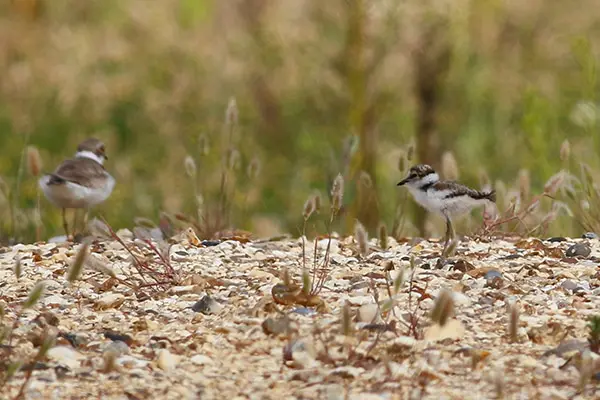Berkshire bird watchers have praised the prompt action of a local quarry operator who put work on hold after Little Ringed Plovers were seen – and thought to be nesting – on a site earmarked for restoration. Ken Moore and his colleagues from Berkshire Ornithological Club (BOC) contacted Grundon Sand & Gravel after spotting at least three pairs of the birds, which migrate thousands of miles every year from Africa.
The Little Ringed Plovers, summer visitors to southern UK shores, made their home at Kennetholme Quarry – known locally as the Brimpton Road gravel pits – and BOC members have been waiting nervously to see if they breed.

“They were feeding on the eastern side of the pits and we could see they were preparing to nest on the western side. If they do so, they’re not allowed by law to be disturbed, so we had to make Grundon aware of what was happening,” explained Ken, a member of the BOC’s conservation committee, which works with local quarry operators to help manage and protect local wildlife.
“As soon as we told them, they put their work on hold, which was brilliant. They have been fantastic in supporting our efforts and coming to the quarry with us to look for the birds. It’s so much nicer to be able to help wildlife together like this, rather than having to bring the law into play.”
Under the Wildlife and Countryside Act 1981, it is an offence to intentionally damage or destroy a wild birds nest and, as the Little Ringed Plovers are a Schedule 1 species, there are also additional penalties for disturbing the birds or their young.
Andrew Short, Grundon’s estates director, said: “When Ken and BOC told us about the Little Ringed Plovers, we immediately postponed our restoration work. After an arduous journey from Africa, the least we can do is ensure the birds have the space and time they need to breed without being disturbed.
“The BOC’s conservation committee does some great work in helping to prioritise conservation of the countryside and birdlife and we’re only too happy to support them and work alongside them as partners, whenever we can.”
The area where the birds were seen is roughly the size of two football pitches and, as part of Grundon’s ongoing programme to restore the land for agricultural use, infilling had already taken place.
The final stage, placing topsoil in the area, was put on hold for around six weeks in case the birds were breeding, although Grundon continued phased restoration elsewhere on the 32 hectare quarry site.
Approximately 2,000 pairs of Little Ringed Plovers – just a little bigger than a sparrow – make the annual journey and, thanks to the large amount of gravel extraction which has taken place throughout the Kennet Valley, the area provides the perfect habitat for breeding.
Bird migration and habitats are monitored by the British Trust for Ornithology (BTO) and Ken’s colleague and BOC chairman, Tim Ball, is one of a select few, specially-licensed, to catch and ring birds on the Schedule 1 list, to gain valuable information and statistics about their breeding and migration patterns.
Ken continued: “We already know that one of our females was ringed two years ago on the south coast in Hampshire, last year she was in Newbury and now she’s in Brimpton, which is fantastic to be able to track.
“Sadly it now seems that the Little Ringed Plovers seen on site have failed, possibly due to predation by foxes, badgers or crows.”
Andrew adds: “At Grundon, quarry restoration is just as important to us as quarrying and selling local building materials. We are very proud of our award-winning restoration schemes – which are generally developed through partnership working with the land owners and partner organisations – as we return land to high quality agricultural use, biodiversity or amenity uses. We are always happy to work with organisations like BTO to support local biodiversity – and will now keep an eye out for Little Ringed Plovers on our site.”
Ken says: “With most of the young birds expected to have fledged by the end of July, the adult birds leave for the return journey to Africa in early August, with their youngsters following on behind more slowly, adding as much body weight as they can in preparation for the long flight, most often making their way to the south coast first, before embarking heading off via southern Europe. We hope to see these amazing small birds return again to this area next year.”
Back to news